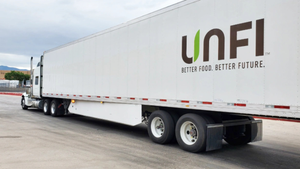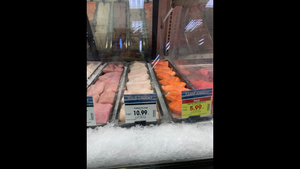Retail Foodservice Readies for the Holiday Rush
Grocers from Uncle Giuseppe’s to Mollie Stone’s share tips for success. Grocers from Uncle Giuseppe’s to Mollie Stone’s Market are gearing up for what could be their most profitable holiday season for prepared food yet.
October 8, 2021

Larger family gatherings and celebrations are back on calendars this holiday season, but as the kitchen fatigue brought on by so many meals made at home during the pandemic lingers, consumers will look to retail foodservice to help cater the affair.
Russell McVeigh, catering director at Uncle Giuseppe’s Marketplace—a Melville, N.Y.-based specialty grocer with nine locations in New York and New Jersey, and a 10th slated to open later this year—is ready for the rush. When it comes to retail foodservice catering operations, “grocers need to be more like restaurants,” he says.
The specialty grocer makes all 140 dishes in its deli cases in-store. “We’ve got 30 people in our kitchens hand-breading eggplant and more,” he explains. “We don’t commissary anything and we’re not a traditional grocery store. We do legit catering with an advanced menu,” continues McVeigh, who adds that Uncle Giuseppe’s also handles waitstaff rentals. Three of its stores have the distinction of serving as official Hyatt caterers.
Headed into this holiday season, retail foodservice needs to be ready not only with an elevated in-store experience, but also with a strong digital presence. The pandemic drove a surge in online ordering at Uncle Giuseppe’s, and as pandemic restrictions ease and people gather once again, McVeigh is seeing yet another wave in demand for catering. He predicts 70% of holiday orders will be online this year.
Catering Doubles Without Trouble
Like many grocers, until recently, Uncle Giuseppe’s kept old school catering books with handwritten orders. And if it wanted to make additions or changes to its catering menu online, it had to make those adjustments for each individual location. It was a time-consuming and often frustrating process, admits McVeigh.
Earlier this year, Uncle Giuseppe’s partnered with FoodStorm, developers of a catering software management system specifically designed for the grocery industry. FoodStorm’s software automates the entire catering/prepared foods ordering, production, payment and fulfillment process from one centralized system.
“Although catering and prepared foods are among a grocer’s most profitable offerings, most grocers still manage these orders using spreadsheets, paper order forms and sticky notes,” says FoodStorm. “Their existing e-commerce, inventory and POS systems don’t support the complexities of catering and prepared foods, including managing production, ingredients, lead times and shelf life.”
Since moving to FoodStorm’s software, Uncle Giuseppe’s has doubled its online catering sales, McVeigh told WGB. The software provides a catering-specific e-commerce website to match the
grocery brand, order and production management, PCI-compliant payment processing, CRM tools to market and grow the business, and reporting features with a live business dashboard.
“Previously, if the price changed on our potato salad, we had to go into the system and manually change it for eight different stores. There were also different taxes on the salad depending on where the store is located,” explains McVeigh. “Now in 10 seconds, we can update the price of an item across all stores.”
Similarly, Uncle Giuseppe’s used to upload catering photography to its website one image at a time for each store. Now McVeigh can instantly upload new images for all stores, effortlessly giving both his internal team and customers an accurate visual depiction of each catering platter.
“Having control of what the shopper sees has been great, and the database is so easy to use—both on our side and the customer’s—it doesn’t make me afraid to try something new,” he adds. Through the FoodStorm online ordering system, customers can also choose whether they want items delivered hot or cold; add a tip; and set a delivery time.
“There’s a proprietary view so we can look at the delivery log for each store and know if we’re booked for deliveries between say 12:00 p.m. and 4:00 p.m. We can then adjust to only take early deliveries,” says McVeigh. With Uncle Giuseppe’s old catering system, which depended heavily on handwritten orders, the delivery function was either on or off. The grocer has further streamlined its delivery operations to offer delivery twice per hour.
Uncle Giuseppe’s catering business is currently “crushing last year’s numbers,” he says. “It’s wild. Our average orders are up $150 year over year,” adds McVeigh who sees a number of contributing factors including pent up demand, the return of weddings and events, and more robust savings accounts among consumers who spent less on food and entertainment during the peak of COVID. “People are now spending faster than we can produce,” he jokes.
Uncle Giuseppe’s newly streamlined online catering offerings also allow customers to include items from multiple departments such as the deli, bakery and produce. As a result, McVeigh estimates bakery catering sales alone will likely double this year compared to last.
In use at thousands of sites around the world, FoodStorm processes over $1.5 billion in catering and prepared food orders for grocers, caterers and corporate dining operations.
“COVID-19 and the continued threat from Amazon and Walmart has really forced independent grocers to differentiate and provide better options in catering and fresh prepared foods,” says Rob Hill, CEO of FoodStorm. “Our software makes it simple for these grocers to execute on this important piece of their business very efficiently and track everything from one central location.”
The Holiday Rush, Handled
Aaron Stone, vice president of the San Francisco Bay Area-based Mollie Stone’s Markets and Hill of FoodStorm recently collaborated to offer grocers tips to prepare for the holiday catering rush—and these execs know a thing or two about navigating the complexities of retail foodservice operations during the holidays. One of FoodStorm’s largest grocery customers prepares over 4,000 turkey dinners for Thanksgiving alone. Their four tips for success:
1. Create targeted menus based on customer taste.
Consider regional cuisines enjoyed by your customer base; dishes that cater to dietary restrictions and preferences; times of year that are important to the local community; and specific events celebrated by customers.
2. Reach new customers through multiple channels.
Connect with new customers through social media, such as Google Retail, Facebook and Instagram. Make sure your e-commerce site is always up to date and mobile-friendly and create email or promotional campaigns online and in-store to communicate your new offerings through those channels.
3. Use customer feedback to pivot quickly.
Once you have your feedback system set up, use it to monitor your business constantly. If customers keep requesting items or changes, consider making an amendment to your offering immediately. Mollie Stone’s successfully did this with its Thanksgiving pies by providing pie selection options for customers to choose themselves instead of offering pre-selected, fixed flavors.
4. Implement technology to streamline.
Manual processes are laborious and prone to errors; using software that can automate many of those jobs lets you focus on your core business without being pulled into repetitive, time-consuming administrative tasks.
Produce on the Menu
As consumers increasingly seek healthier options in this next phase of the pandemic, the inclusion of more fruits and vegetables in holiday catering and everyday retail foodservice operations is key. WGB asked three produce industry experts to share their tips for maximizing produce in deli/prepared foods.
Joe Watson, Produce Marketing Association (PMA)
1. Select seasonal vegetables as prepared sides that can be packaged for purchase and merchandised adjacent to main course items and include these in the service area as well to allow customers to select the amount they want to purchase. Offering to reheat prepared sides for onsite consumption is another opportunity for retailers.
2. Create a vegetarian/vegan section that also appeals to flexitarians. The selection doesn’t have to be broad, but rather a focused group of products which will appeal to mainstream consumers who value these options.
3. An often-overlooked opportunity is for the retail foodservice department to partner with the produce procurement team to maximize their collective volume. Product specifications can be a challenge to overcome, but the cost savings can be substantial.
Diana McClean, Senior Director of Marketing, Ocean Mist Farms
1. Add value-added/washed and ready-to-use (or microwave) fresh produce items to the deli/prepared foods section for those shoppers who are looking for quick, balanced and complete meal solutions. Merchandising these items in one place gets them closer together in the store and in the minds of the shoppers.
2. Cross merchandise value-added produce with complementary ingredients to complete the meal. Fresh vegetables are not always a side dish, and with the addition of a protein, seasonings or a prepared grain salad from the deli, a nutritious meal is only a few steps away.
3. Make it simple. Utilize POS materials that highlight the meal solutions, and literally show your shoppers how easy it is to eat both fresh and healthy.
Megan McKenna, Senior Director of Marketing and Foodservice, Watermelon Board
1. Cut watermelons for the best yield and think of different size and shape cuts to use in dishes to surprise your customers, like a yogurt parfait with watermelon. Learn how at www.watermelon.org.
2. Use the whole watermelon, including the rind, to reduce food waste and create new sales opportunities in approachable applications like pickles and slaws.
3. While watermelon is a great hydrator at 92% water, to maintain the product’s integrity in prepared foods, think about stacking, skewering or using more trendy grains that allow the fruit to hold up in a salad.
About the Author
You May Also Like






